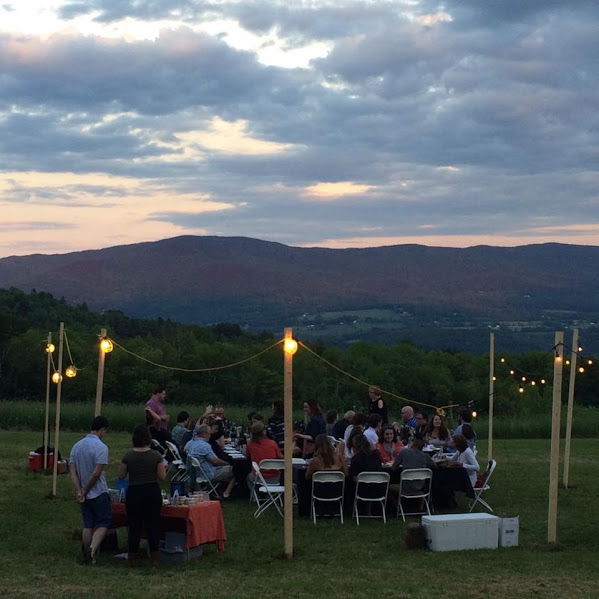I just got back from three days immersed in the Vermont craft beverage world as part of my annual TasteCamp conference. I started it in 2009 right here on Long Island and we’ve visited wine regions like Northern Virginia, Niagara (both sides of the border), the Finger Lakes, Quebec and the Hudson Valley since.
Typically, I’m joined by 30-40 fellow writers and members of the wine trade. The idea is to taste as much as we can and meet as many brewers, winemakers, growers and other fermentation-ists as possible. It’s not a junket, either. We all pay our own way.
It’s a whirlwind, but it’s always eye-opening and educational.
Traveling to towns like Barnard, Shelburne and Middlebury, it’s easy to lose one’s self in the stunning views of Vermont. The mountains, the rivers and the lakes — both big and small — are simply beautiful and still feel so untouched in many ways. Nestled among all that natural beauty are some similarly striking beverages that are only now just beginning to get the attention they deserve. All just a few hours drive north once you take one of the ferries across Long Island Sound to Connecticut.
I’m still unpacking all of the information that I absorbed. All of the tastes, the textures and the personalities behind them but there is a common vein that runs through everything that is happening in the Vermont beverage industry — a pioneering spirit filled with adventure and opportunity.
It gets downright cold in the winter up there — too cold for the grapes grown here on Long Island and in much of the rest of the wine world — so they don’t even try. You’ll hear the term “cool-climate wines” thrown around a lot these days. This isn’t a cool climate. This is a cold climate. It gets into the minus-20s in the winter. Temperatures like that would decimate Long Island’s vineyards.
You won’t find merlot or chardonnay growing in Vermont. The only traditional grape we even heard mentioned all weekend was riesling — and even that is borderline.
Instead, grapes that you’ve maybe never heard of make up the bulk of the Vermont’s wines — La Crescent, L’acadie Blanc, Frontenac (noir, gris and blanc), Marquette, Brianna, Louise Svenson and more. Many of these grapes are known as “Minnesota Varieties” because they were developed at the University of Minnesota to survive that state’s cold winters. They can survive frigid winters, but they also bud later in the spring to mitigate against mid-to-late May frosts. They are also able to ripen in a relatively short period of time. And they tend to be very high in acidity.
Because of their unique chemistry and flavor qualities, winemaking is different here, and that’s what makes the wines so exciting and interesting. Without Old World (or even California) equivalents or centuries-old traditions, Vermont winemakers are free to embrace the distinctiveness of these grapes and blaze their own trail.
There are several semi-sweet wines aimed at tourists who enjoy them, but there is also a handful of quality-focused producers that any wine lover should know.
Of the red wines we tasted, the Marquette-based wines show the most potential. The best examples are made with little-to-no new oak and live in the crunchy delicious area between gamay and pinot noir. A tank sample of an unoaked 2015 Marquette at Shelburne Vineyard was a standout — probably the best red wine I tasted — but Lincoln Peak Vineyard is a clear leader with the grape. Owner and winemaker Chris Granstrom was one of the first people in the world to commercially plant Marquette, which only became available in 2006. “It’s easy to over-oak Marquette,” he said during our visit, so he’s taken his foot off the oak pedal. Huntington River Vineyard, a tiny 300-case per year winery, also makes a delicious example.
Of the white grapes we tasted, La Crescent seems to be the most interesting today. It’s an aromatic grape not unlike riesling or even gewürztraminer (minus the rose pedal aromas). Shelburne Vineyards’ is off-dry and peachy, with crackling acidity. At Lincoln Peak, the varietal La Crescent was good, but when blended with Frontenac Blanc for a wine they call “Limestone,” it shines bright. That wine is citrusy and faintly minerally. I came home with a couple bottles.
My personal favorite wines of the weekend came from la garagista, Deirdre Heekin and Caleb Barber’s small winery on the side of a mountain in Barnard. Their property is a magical place better seen for yourself than described by any writer. And the wines, particularly the two pet nat sparkling wines, are singular, expressive and just plain delicious. Their Ci Confonde petillant naturel White, made from the Brianna grape, is floral and bright but also super-savory with beautiful herbal and saline notes. Ci Confonde petillant naturel Rosé, made with Frontenac Gris, is an electric dark pink and bursts with berries and flowers. I drank a bottle with my wife when I got home from the trip. I couldn’t wait to share it with her.
I don’t have the space in this column to tell you about all of the great ciders, spirits and beers we tasted. Oh, and the cheese. You can’t visit Vermont without tasting the cheese.
I’ll admit that I didn’t realize just how close these wineries are — no farther than visiting the Finger Lakes. I’ll be back. You should check it out, too.
(This column originally appeared in the Suffolk Times. You can read it here.)

